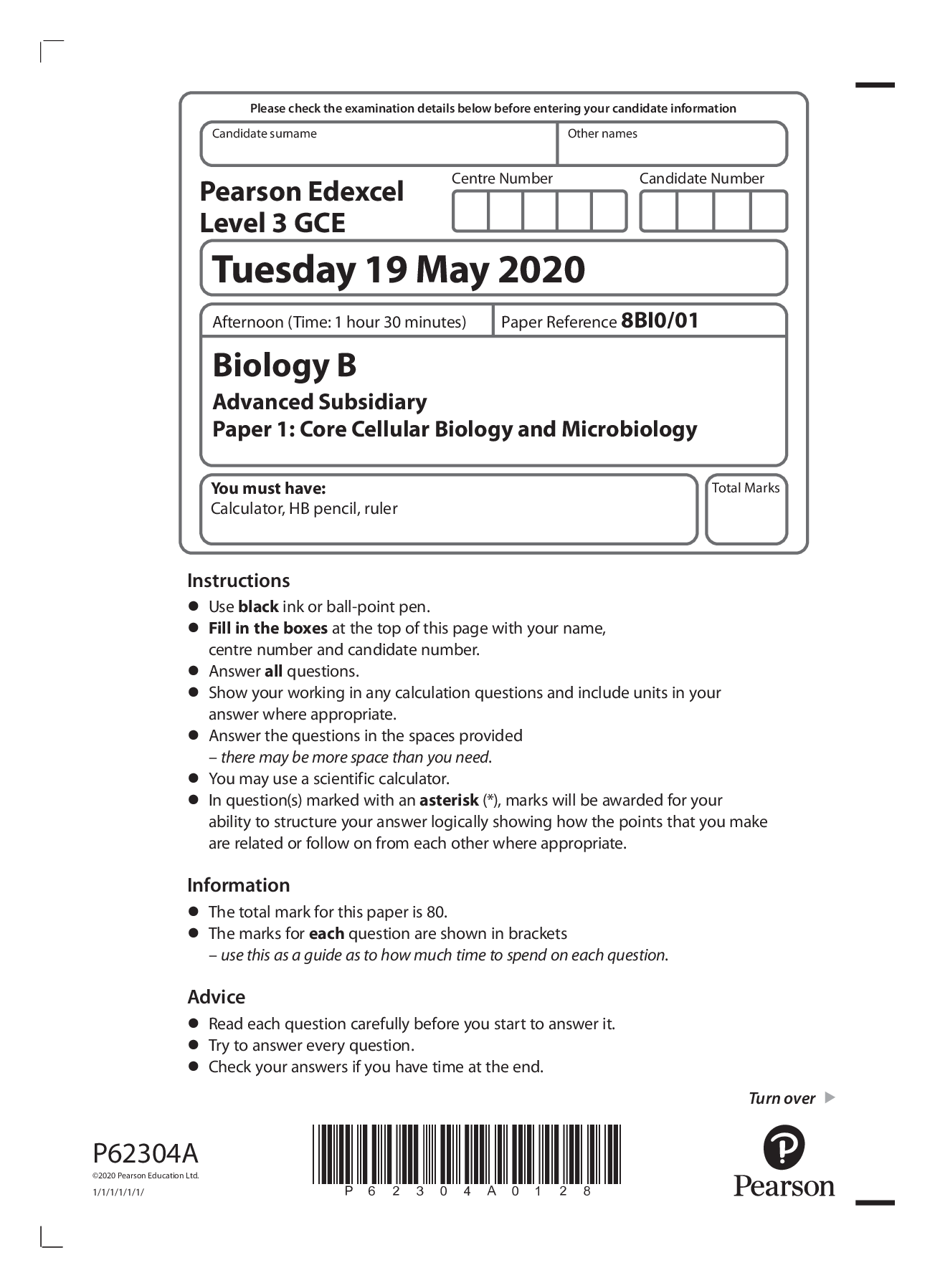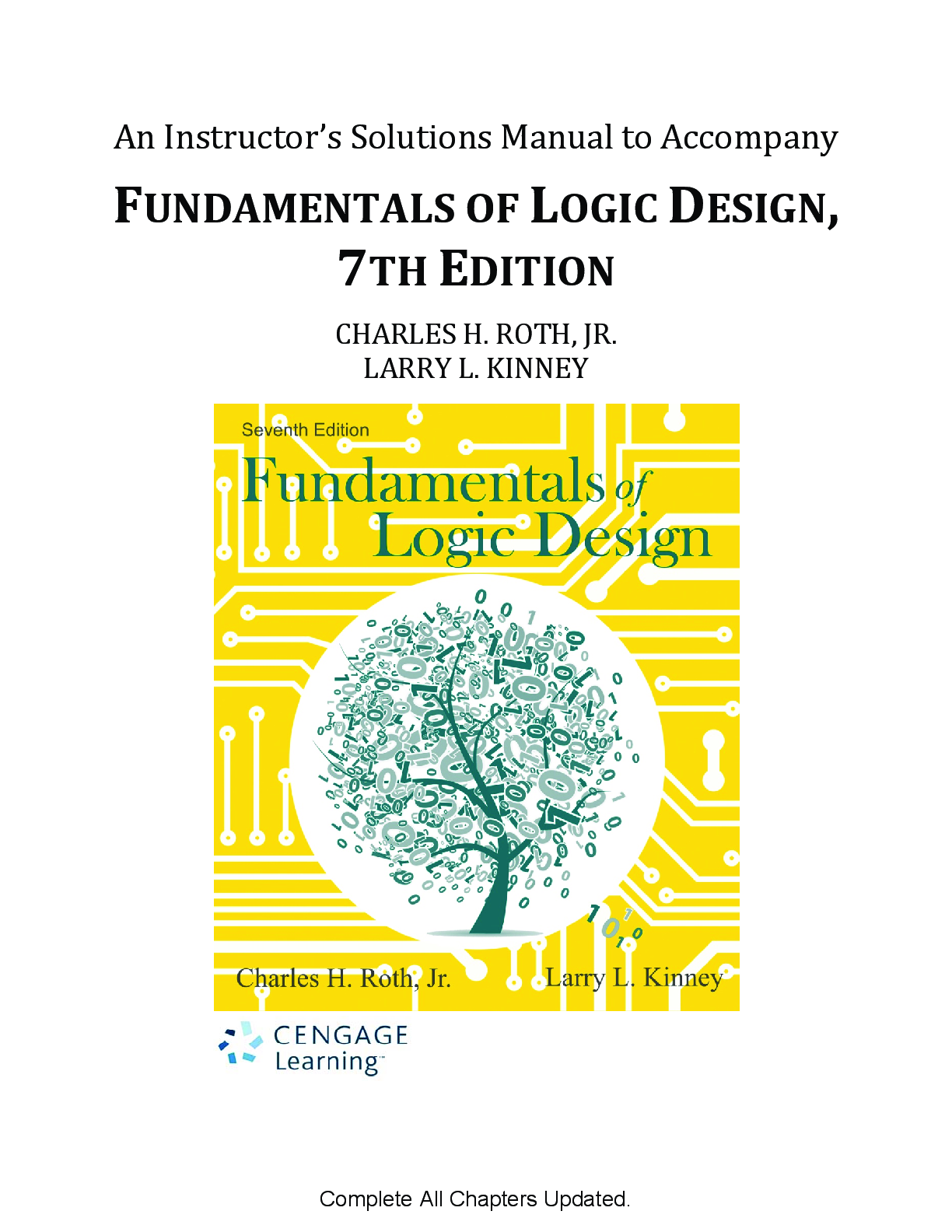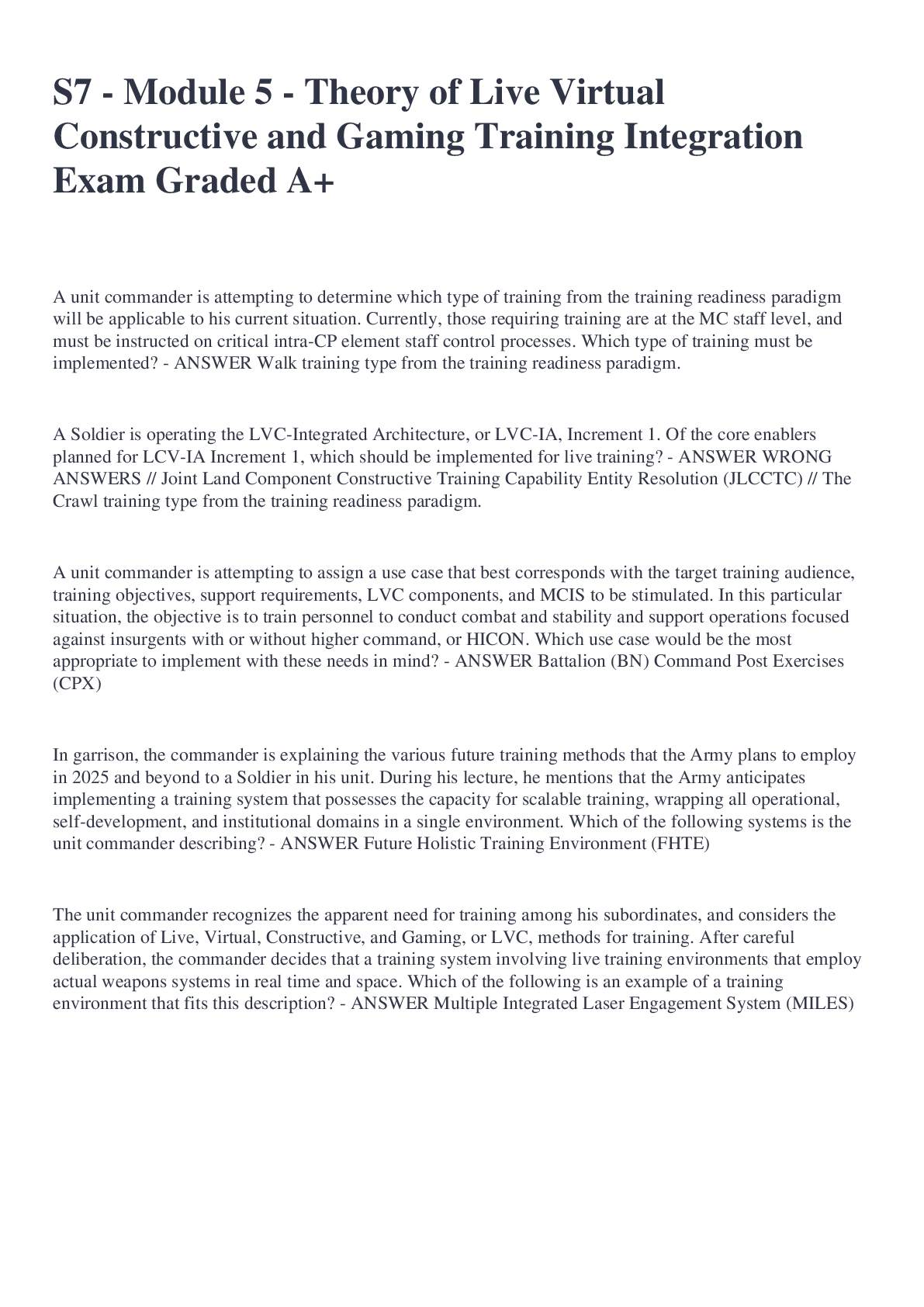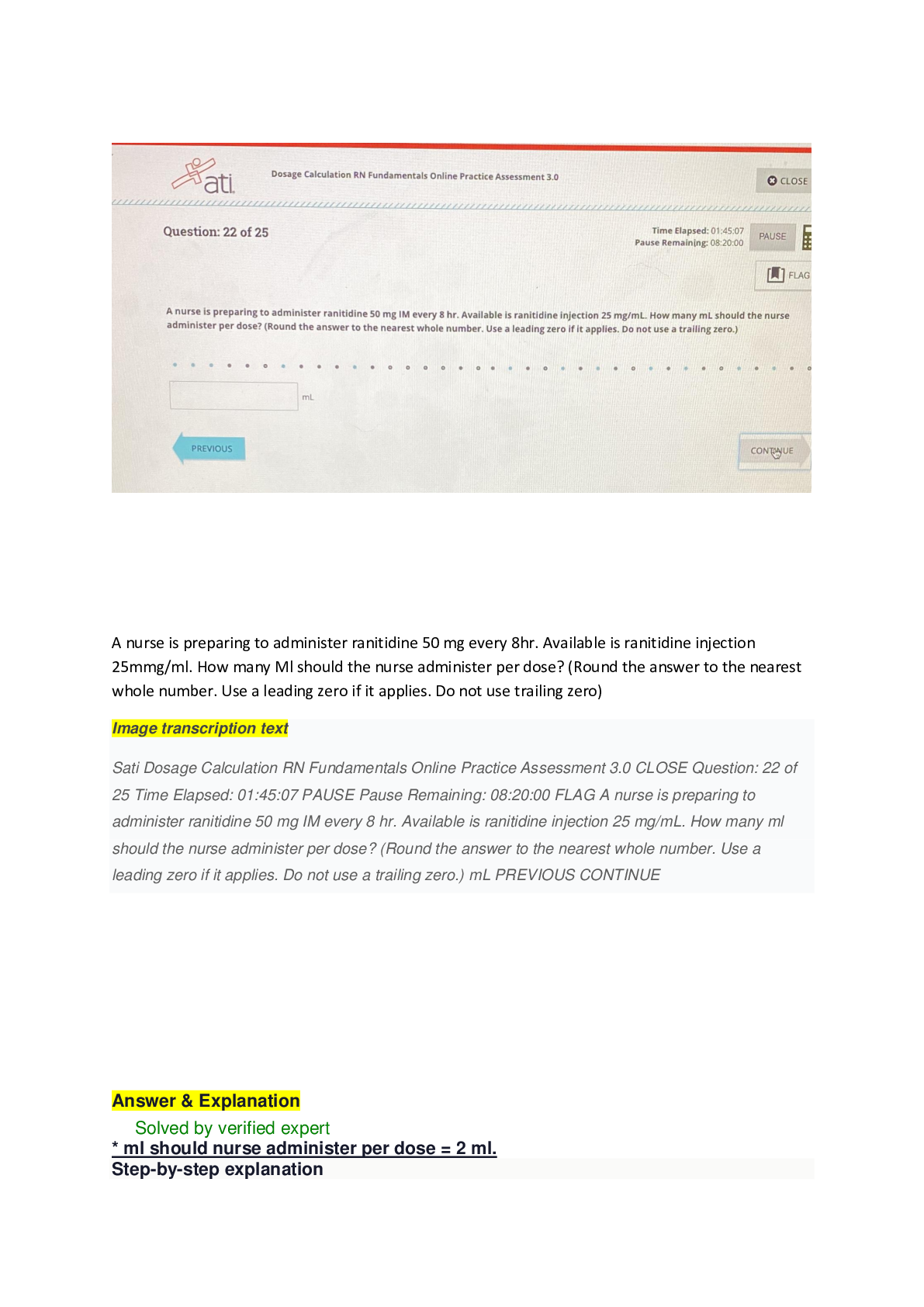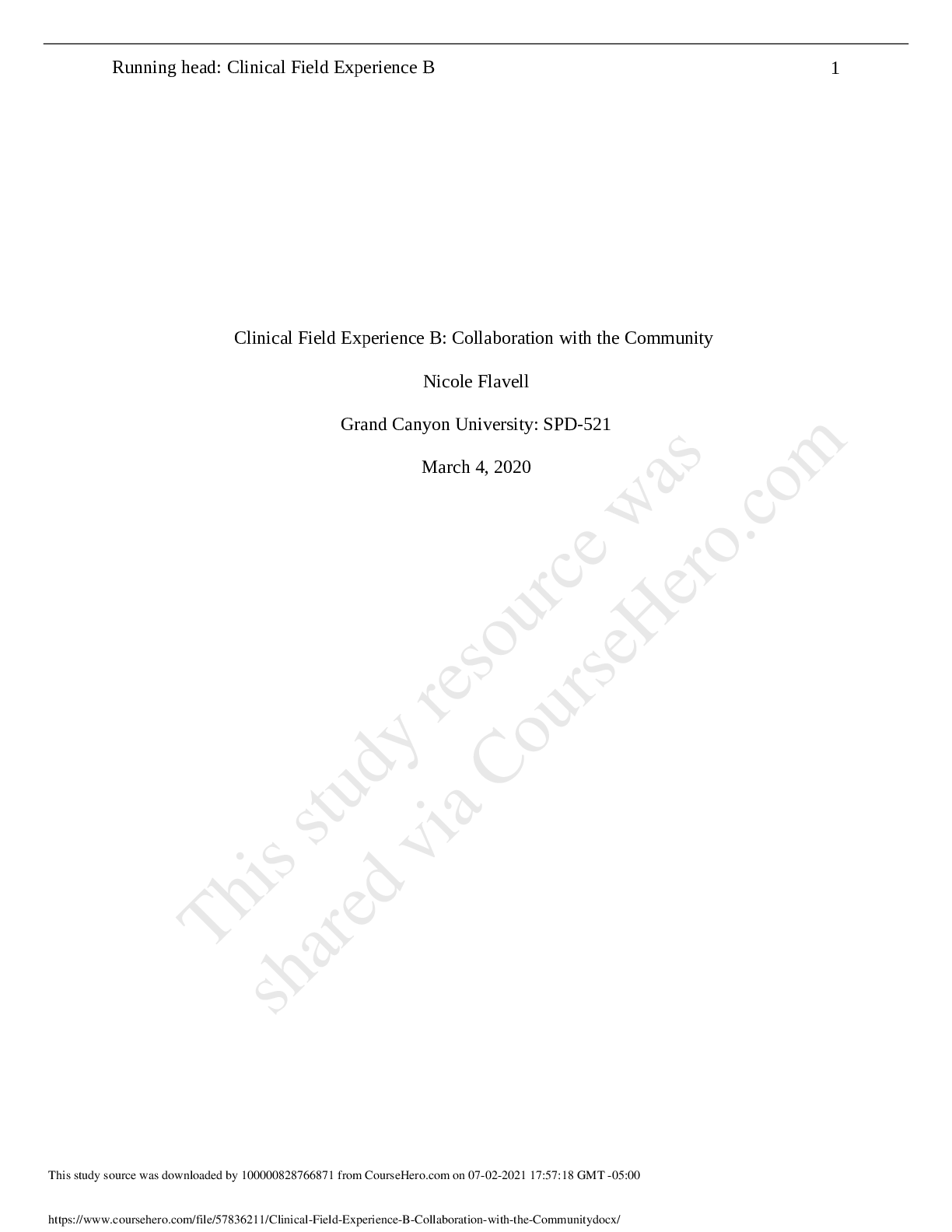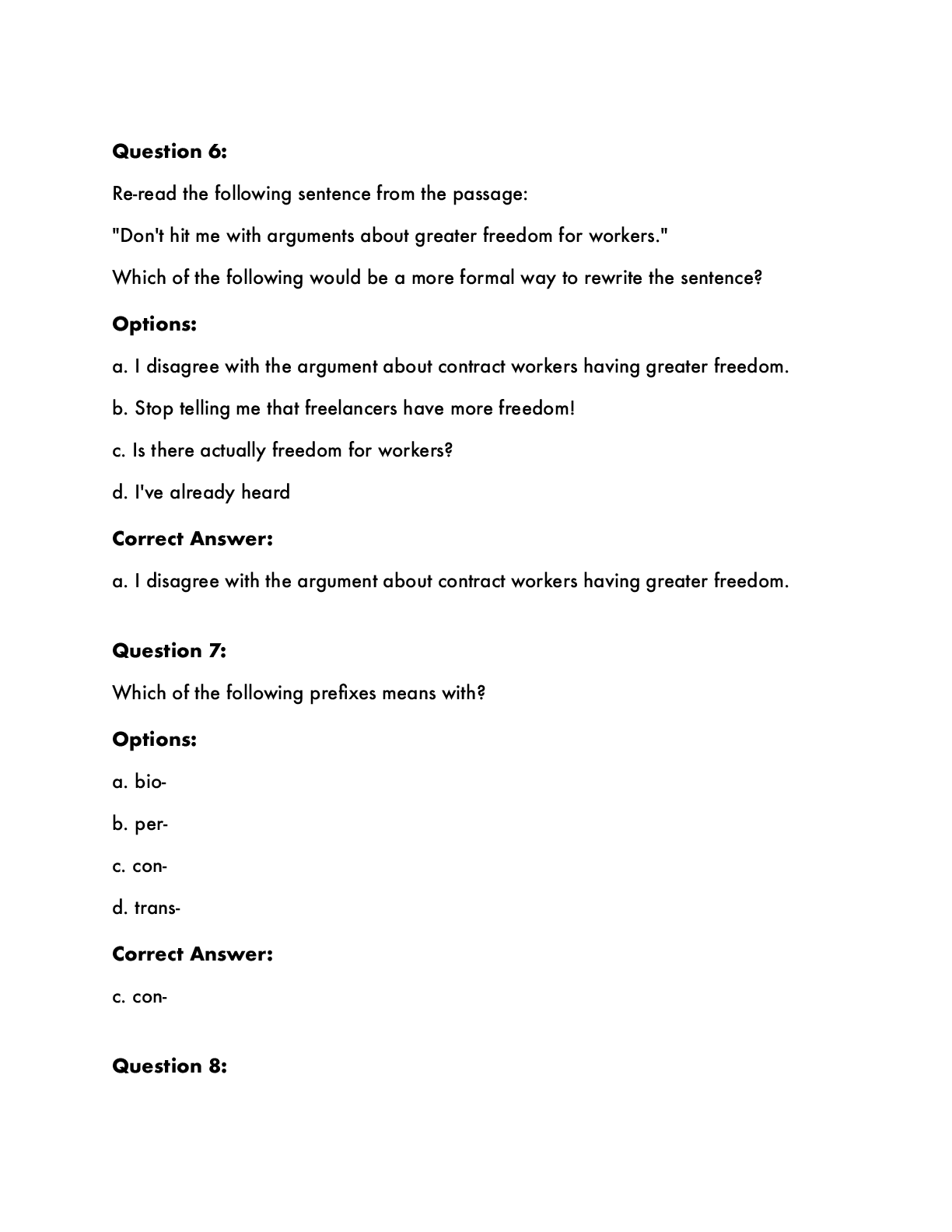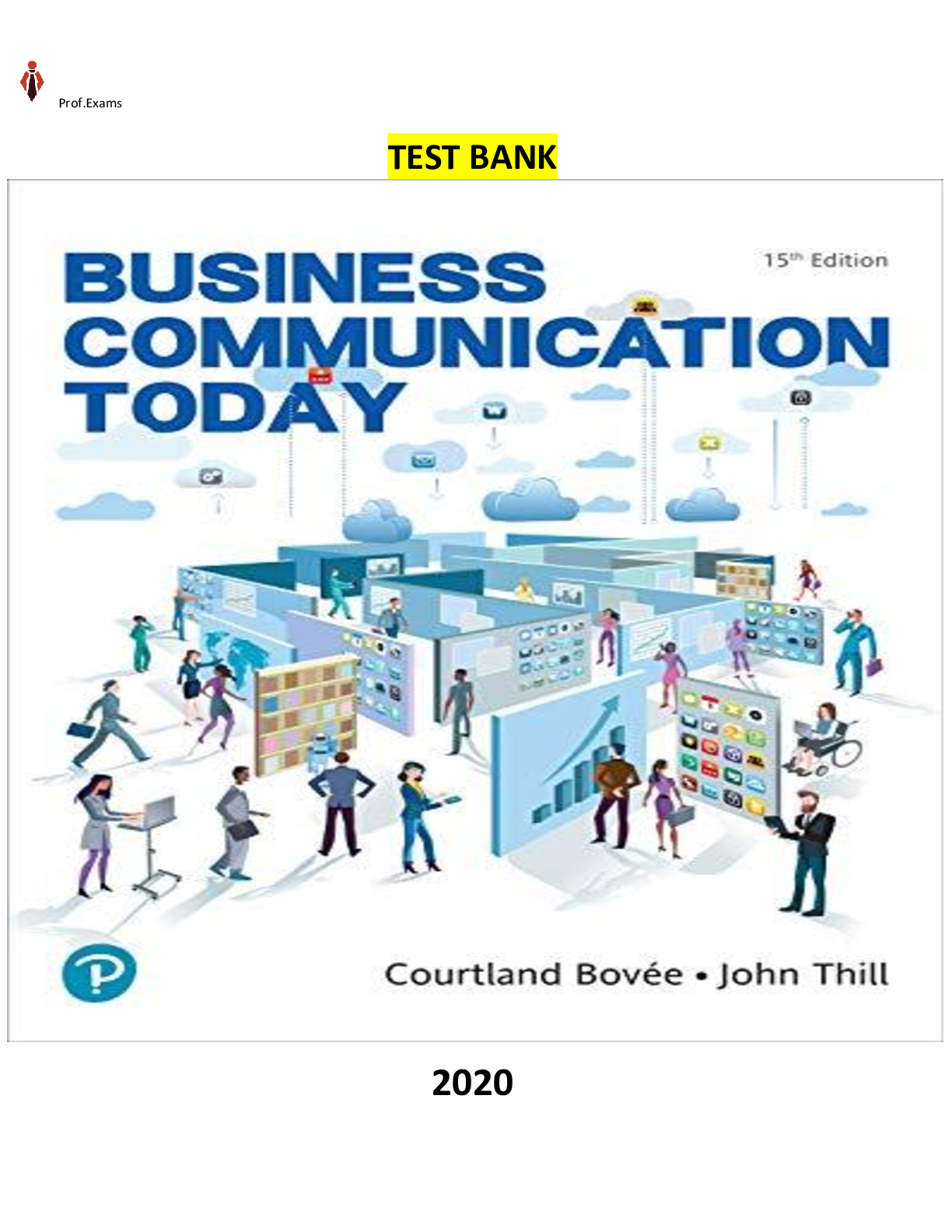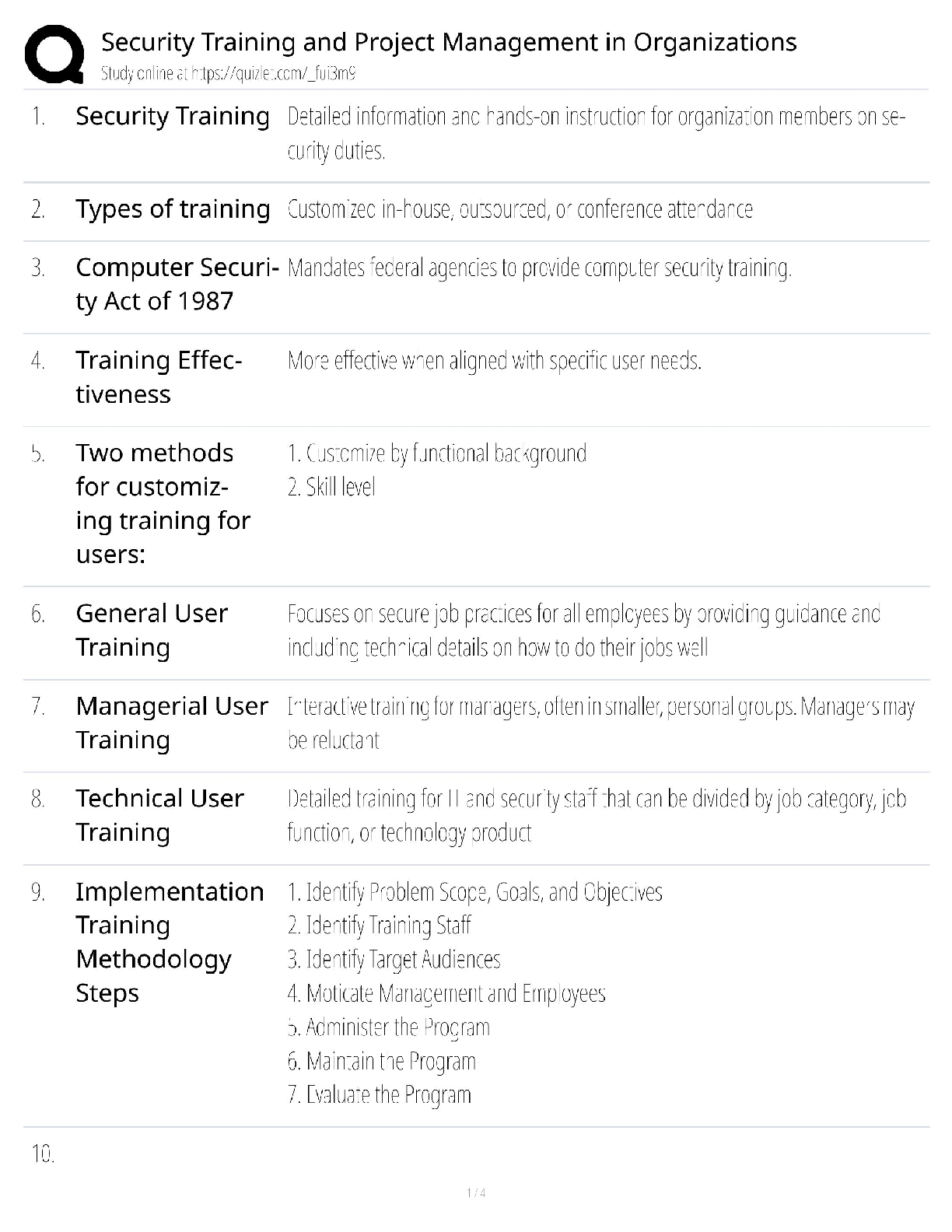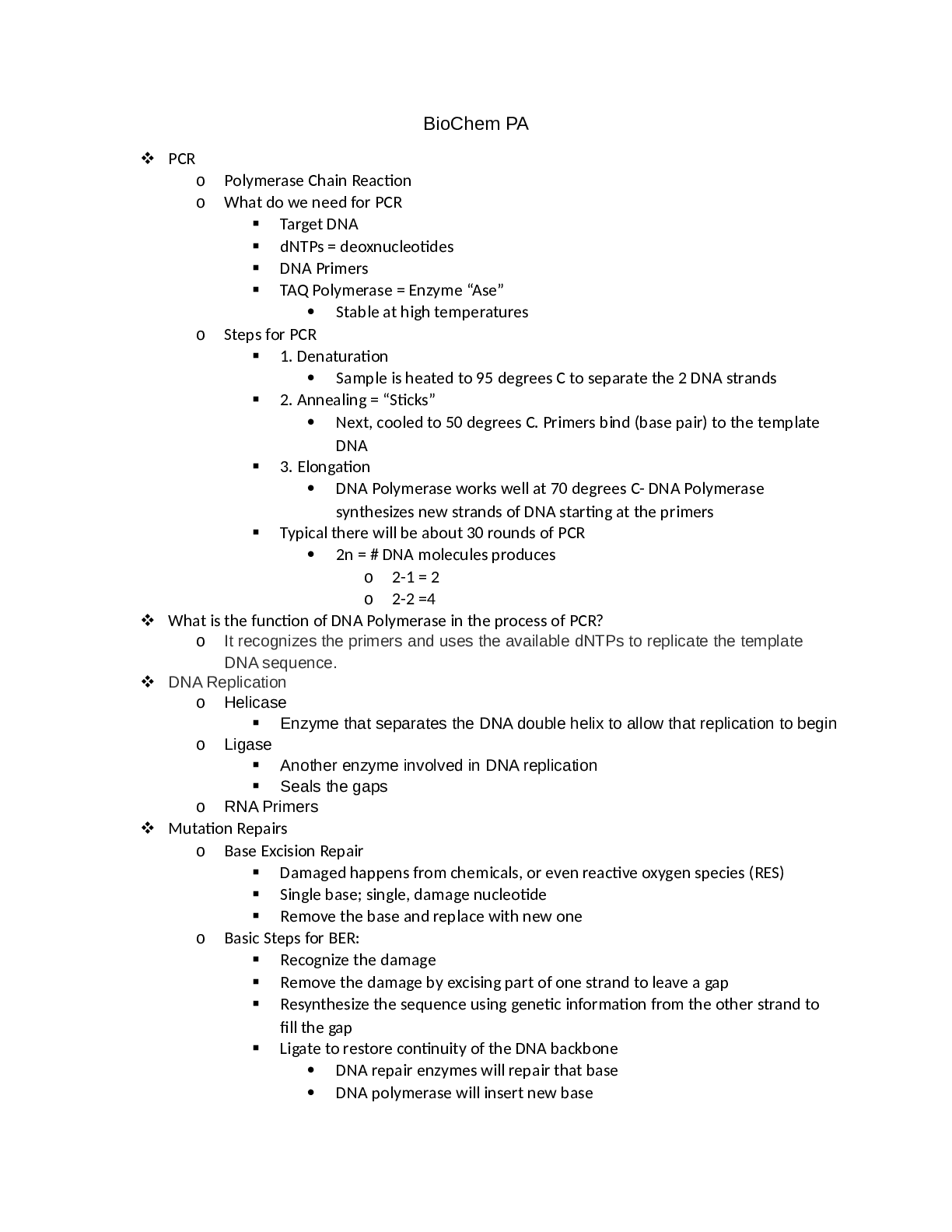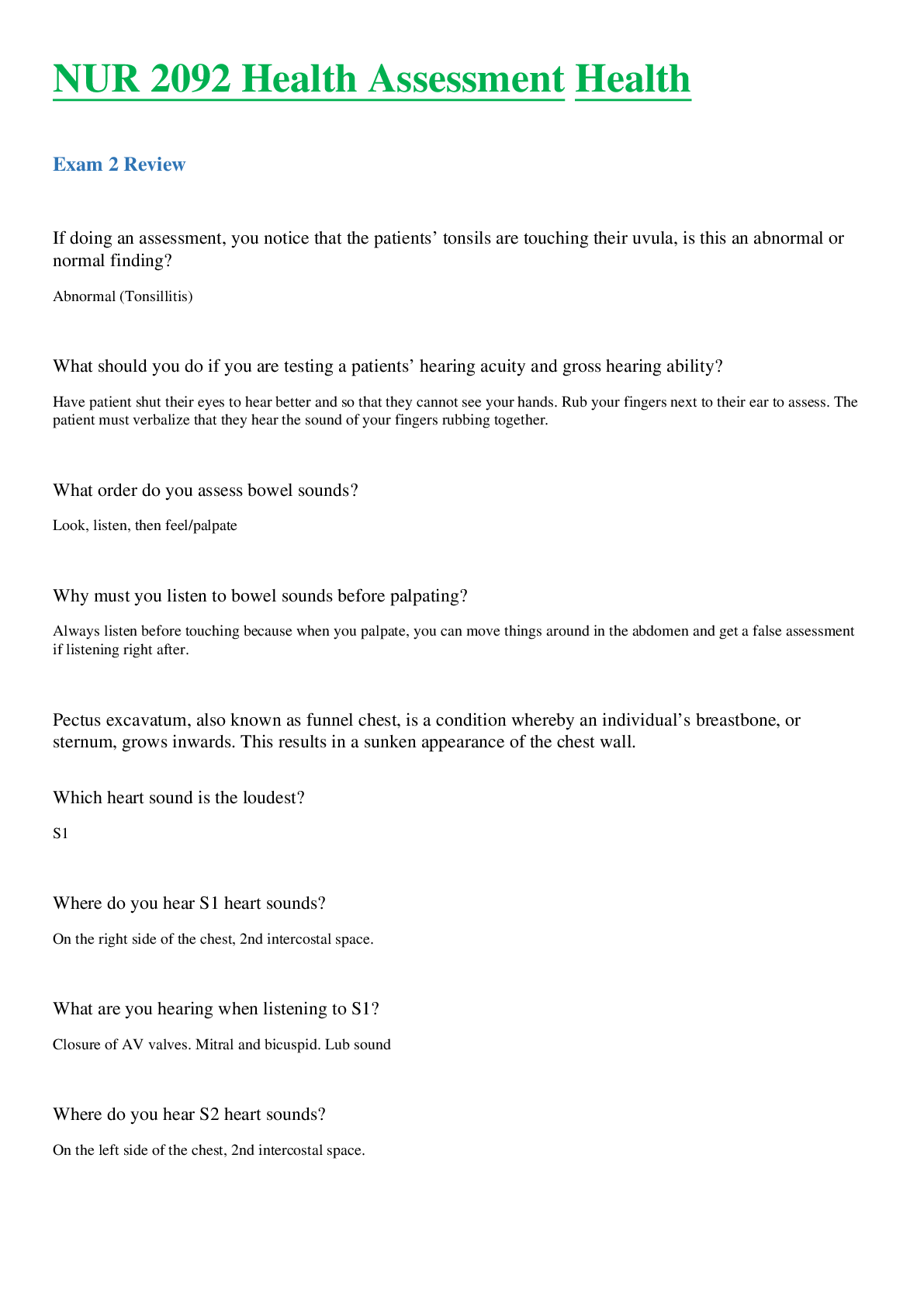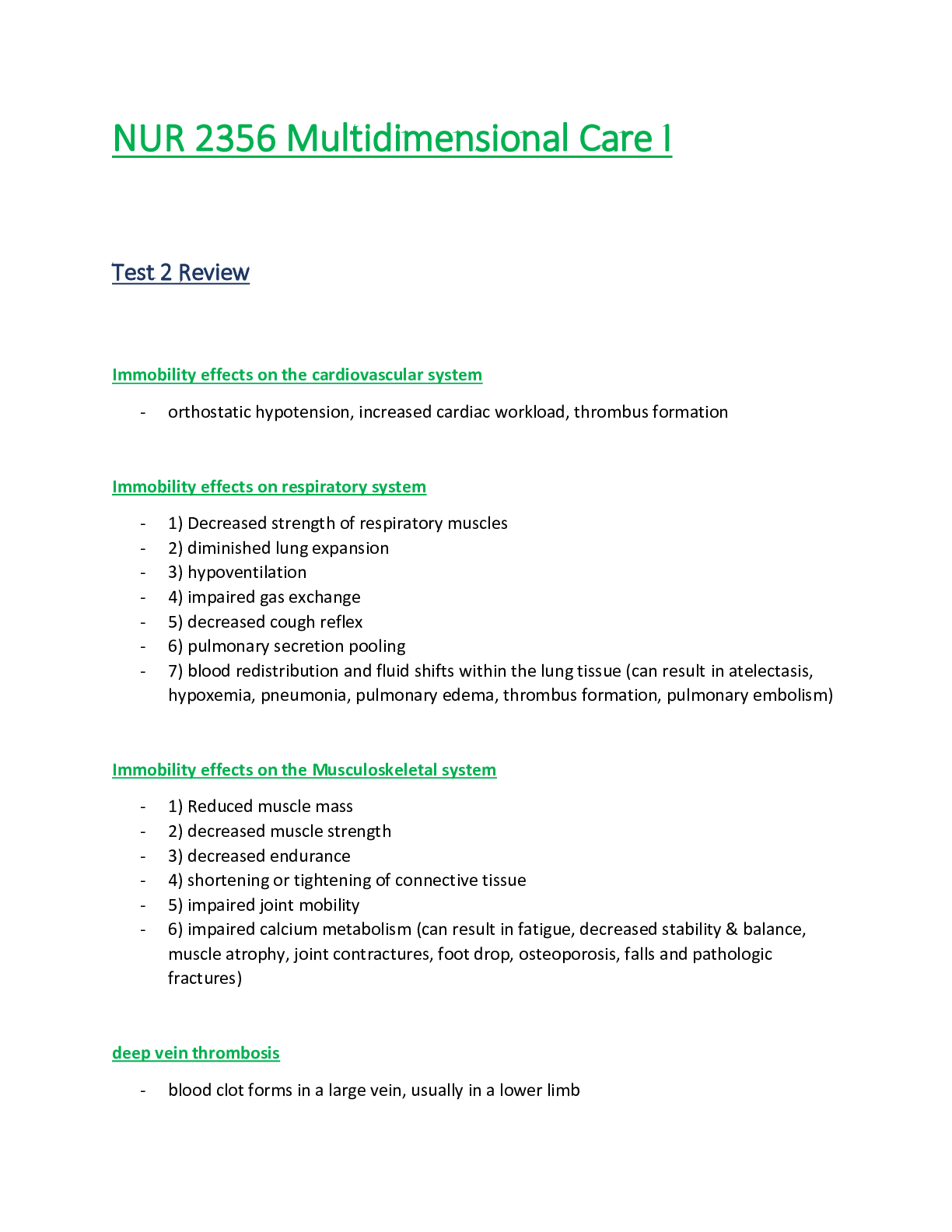Health Assessment in Nursing 5th Edition by Janet R
Document Content and Description Below
1. A nurse on a postsurgical unit is admitting a client following the client’s
cholecystectomy (gall bladder removal). What is the overall purpose of assessment for
this client?
A) Collecting acc
...
urate data
B) Assisting the primary care provider
C) Validating previous data
D) Making clinical judgments
2. A client has presented to the emergency department (ED) with complaints of abdominal
pain. Which member of the care team would most likely be responsible for collecting
the subjective data on the client during the initial comprehensive assessment?
A) Gastroenterologist
B) ED nurse
C) Admissions clerk
D) Diagnostic technician
3. The nurse has completed an initial assessment of a newly admitted client and is applying
the nursing process to plan the client’s care. What principle should the nurse apply when
using the nursing process?
A) Each step is independent of the others.
B) It is ongoing and continuous.
C) It is used primarily in acute care settings.
D) It involves independent nursing actions.
4. The nurse who provides care at an ambulatory clinic is preparing to meet a client and
perform a comprehensive health assessment. Which of the following actions should the
nurse perform first?
A) Review the client’s medical record.
B) Obtain basic biographic data.
C) Consult clinical resources explaining the client’s diagnosis.
D) Validate information with the client.
5. Which of the following client situations would the nurse interpret as requiring an
emergency assessment?
A) A pediatric client with severe sunburn
B) A client needing an employment physical
C) A client who overdosed on acetaminophen
D) A distraught client who wants a pregnancy test
Page 2
6. In response to a client’s query, the nurse is explaining the differences between the
physician’s medical exam and the comprehensive health assessment performed by the
nurse. The nurse should describe the fact that the nursing assessment focuses on which
aspect of the client’s situation?
A) Current physiologic status
B) Effect of health on functional status
C) Past medical history
D) Motivation for adherence to treatment
7. After teaching a group of students about the phases of the nursing process, the instructor
determines that the teaching was successful when the students identify which phase as
being foundational to all other phases?
A) Assessment
B) Planning
C) Implementation
D) Evaluation
8. The nurse has completed the comprehensive health assessment of a client who has been
admitted for the treatment of community-acquired pneumonia. Following the
completion of this assessment, the nurse periodically performs a partial assessment
primarily for which reason?
A) Reassess previously detected problems
B) Provide information for the client’s record
C) Address areas previously omitted
D) Determine the need for crisis intervention
9. The nurse is working in an ambulatory care clinic that is located in a busy, inner-city
neighborhood. Which client would the nurse determine to be in most need of an
emergency assessment?
A) A 14-year-old girl who is crying because she thinks she is pregnant
B) A 45-year-old man with chest pain and diaphoresis for 1 hour
C) A 3-year-old child with fever, rash, and sore throat
D) A 20-year-old man with a 3-inch shallow laceration on his leg
Page 3
10. A nurse has completed gathering some basic data about a client who has multiple health
problems that stem from heavy alcohol use. The nurse has then reflected on her personal
feelings about the client and his circumstances. The nurse does this primarily to
accomplish which of the following?
A) Determine if pertinent data has been omitted
B) Identify the need for referral
C) Avoid biases and judgments
D) Construct a plan of care
11. The nurse is collecting data from a client who has recently been diagnosed with type 1
diabetes and who will begin an educational program. The nurse is collecting subjective
and objective data. Which of the following would the nurse categorize as objective data?
A) Family history
B) Occupation
C) Appearance
D) History of present health concern
12. An older adult client has been admitted to the hospital with failure to thrive resulting
from complications of diabetes. Which of the following would the nurse implement in
response to a collaborative problem?
A) Encourage the client to increase oral fluid intake.
B) Provide the client with a bedtime protein snack.
C) Assist the client with personal hygiene.
D) Measure the client’s blood glucose four times daily.
13. The nurse at a busy primary care clinic is analyzing the data obtained from the
following clients. For which clients would the nurse most likely expect to facilitate a
referral?
A) An 80-year-old client who lives with her daughter
B) A 50-year-old client newly diagnosed with diabetes
C) An adult presenting for an influenza vaccination
D) A teenager seeking information about contraception
14. An instructor is reviewing the evolution of the nurse’s role in health assessment. The
instructor determines that the teaching was successful when the students identify which
of the following as the major method used by nurses early in the history of the
profession?
A) Natural senses
B) Biomedical knowledge
C) Simple technology
D) Critical pathways
Page 4
15. When describing the expansion of the depth and scope of nursing assessment over the
past several decades, which of the following would the nurse identify as being the
primary force?
A) Documentation
B) Informatics
C) Diversification
D) Technology
16. A group of nurses are reviewing information about the potential opportunities for nurses
who have advanced assessment skills. When discussing phenomena that have
contributed to these increased opportunities, what should the nurses identify?
A) Expansion of health care networks
B) Decrease in client participation in care
C) The shrinking cost of medical care
D) Public mistrust of physicians
17. A nurse has documented the findings of a comprehensive assessment of a new client.
What is the primary rationale that the nurse should identify for accurate and thorough
documentation?
A) Guaranteeing a continual assessment process
B) Identifying abnormal data
C) Assuring valid conclusions from analyzed data
D) Allowing for drawing inferences and identifying problems
18. A nurse has received a report on a client who will soon be admitted to the medical unit
from the emergency department. When preparing for the assessment phase of the
nursing process, which of the following should the nurse do first?
A) Collect objective data.
B) Validate important data.
C) Collect subjective data.
D) Document the data.
19. A community health nurse is assessing an older adult client in the client’s home. When
the nurse is gathering subjective data, which of the following would the nurse identify?
A) The client’s feelings of happiness
B) The client’s posture
C) The client’s affect
D) The client’s behavior
Page 5
20. A nurse on the hospital’s subacute medical unit is planning to perform a client’s focused
assessment. Which of the following statements should inform the nurse’s practice?
A) The focused assessment should be done before the physical exam.
B) The focused assessment replaces the comprehensive database.
C) The focused assessment addresses a particular client problem.
D) The focused assessment is done after gathering subjective data.
21. The nurse is reviewing a client’s health history and the results of the most recent
physical examination. Which of the following data would the nurse identify as being
subjective? Select all that apply.
A) ìI feel so tired sometimes.î
B) Weight: 145 lbs
C) Lungs clear to auscultation
D) Client complains of a headache
E) ìMy father died of a heart attack.î
F) Pupils equal, round, and reactive to light
22. The nurse has been applying the nursing process in the care of an adult client who is
being treated for acute pancreatitis. Place the nurse’s actions in their proper sequence
from first to last.
A) Identifying outcomes
B) Determining client’s nursing problem
C) Collecting information about the client
D) Determining outcome achievement
E) Carrying out interventions
23. A nurse is completing an assessment that will involve gathering subjective and objective
data. Which of the following assessment techniques will best allow the nurse to collect
objective data?
A) Inspection
B) Therapeutic communication
C) Interviewing
D) Active listening
24. The nurse is performing a health assessment on a community-dwelling client who is
recovering from hip replacement surgery. Which of the following actions should the
nurse prioritize during assessment?
A) Focus the assessment on the client as a member of her age group.
B) Interpret the information about the client in context.
C) Corroborate the client’s statements with trusted sources.
D) Gather information from a variety of sources.
Page 6
25. A client comes to the health care provider’s office for a visit. The client has been seen in
this office on occasion for the past 5 years and arrives today complaining of a fever and
sore throat. Which type of assessment would the nurse most likely perform?
A) Comprehensive assessment
B) Ongoing assessment
C) Focused assessment
D) Emergency assessment
26. A nurse has assessed a client who was admitted to the medical unit to treat acute
complications of type 1 diabetes. During the assessment, the client admitted that his
blood sugar monitoring when he is at home is ìa bit sporadic.î How should the nurse
best respond to this assessment finding?
A) Identify a nursing diagnosis of Ineffective Health Maintenance.
B) Identify a collaborative problem that should involve the occupational therapist.
C) Make a referral to the unit’s social work department.
D) Reassess the client’s blood glucose level.
27. The nurse is utilizing the Health Belief Model in the care of a client whose type 1
diabetes is inadequately controlled. When implementing this model, the nurse should
begin by assessing which of the following?
A) The client’s motivation for change
B) The client’s medical comorbidities
C) The client’s learning style
D) The client’s prognosis for recovery
28. A nurse will complete an initial comprehensive assessment of a 60-year-old client who
is new to the clinic. What goal should the nurse identify for this type of assessment?
A) Identify the most appropriate forms of medical intervention for the client.
B) Determine the most likely prognosis for the client’s health problem.
C) Identify the status of the client’s airway, breathing, and circulation.
D) Establish a baseline for the comparison of future health changes.
29. A nurse who provides care in a hospital setting is creating a plan of nursing care for a
client who has a diagnosis of chronic renal failure. The nurse’s plan specifies frequent
ongoing assessments. The frequency of these nursing assessments should be primarily
determined by what variable?
A) The client’s age
B) The unit’s protocols
C) The client’s acuity
D) The nurse’s potential for liability
Page 7
30. A client who is new to the facility has a recent history of chronic pain that is attributed
to fibromyalgia. The nurse has reviewed the available health records and suspects that
pain management will be a major focus of nursing care. How can the nurse best validate
this assumption?
A) Review the client’s medication administration record for analgesic use.
B) Ask the client about the most recent experiences of pain.
C) Meet with the client’s spouse and daughter to discuss the client’s pain.
D) Collaborate with the physician who is treating the client.
1. A nurse has completed a comprehensive assessment of a client and has begun the
process of data analysis. Data analysis should allow the nurse to produce which of the
following direct results?
A) Outcomes evaluation
B) Nursing diagnoses
C) Holistic interventions
D) An interdisciplinary plan of care
2. A new nursing graduate recently made an oversight during the analysis of a client’s
assessment data that resulted in a postoperative complication. What characteristic of
data analysis makes it a challenging aspect of nursing practice?
A) Abnormal data must be identified.
B) It requires the prior identification of nursing diagnoses.
C) It requires sophisticated diagnostic reasoning skills.
D) Conclusions must be clearly and accurately documented.
3. A hospital nurse has identified a need to improve her critical thinking skills in an effort
to improve client care. The nurse should identify which of the following characteristics
of critical thinking?
A) It is an innate skill that some individuals possess and which others do not.
B) It does not include past experiences.
C) It is based primarily on getting correct and timely information.
D) It involves reflections on thoughts before reaching conclusions.
4. The emergency department has collected extensive data from a client who has presented
with a new onset of severe abdominal pain. What nursing action should the nurse
perform before proceeding with data analysis?
A) Validate the collected data.
B) Formulate a nursing diagnosis.
C) Make inferences about the data.
D) Identify the client’s strengths.
5. A nurse has completed a client’s initial assessment and is preparing to identify abnormal
data and the client’s strengths. Successful completion of this phase of the nursing
process most requires which of the following?
A) Knowledge of anatomy and physiology
B) Awareness of the client’s medical prognosis
C) Inferences about the client
D) Knowledge about the referral process
6. A nurse is planning a client’s care following the completion of an initial assessment.
When formulating a risk nursing diagnosis, which piece of data would be most useful?
A) The client has an elevated white blood cell count.
B) The client is 66 years of age.
C) The client has pain in her joints, especially in the morning.
D) The client is separated from her usual social supports.
7. During the assessment interview, the client made numerous statements that suggested
his life generally exists in a state of harmony and balance. This fact would most likely
prompt the nurse to identify which of the following?
A) Actual nursing diagnosis
B) Risk nursing diagnosis
C) Collaborative problem
D) Health promotion diagnosis
8. A nurse is caring for a client who has been admitted with an infected venous ulcer. The
nurse determines that the client will need medical interventions as well as nursing
interventions. The nurse would identify which of the following?
A) Actual nursing diagnosis
B) Referral
C) Risk nursing diagnosis
D) Collaborative problem
9. A nurse has assessed a client and identified data that are associated with the diagnoses
of Impaired Physical Mobility and Activity Intolerance. How can the nurse best
determine which nursing diagnosis is most applicable to the client?
A) Document preliminary conclusions.
B) Identify abnormal data.
C) Check the defining characteristics of the diagnoses.
D) Test the nursing diagnoses clinically.
10. A nurse is analyzing the assessment data of a client who has been admitted with
exacerbation of heart failure. The nurse has determined that the cue clusters meet the
defining characteristics of specific nursing diagnoses. Which of the following would the
nurse do next?
A) Explain the client’s problems to the client and his or her family.
B) Verify it with the client and with other health care professionals.
C) Validate the diagnosis with the physician.
D) Work with the client to begin planning interventions.
Page 3
11. A nurse’s data analysis has led to the formulation of a risk nursing diagnosis. Which of
the following best demonstrates accurate documentation of a risk nursing diagnosis?
A) Risk for fatigue related to increased job demands, as manifested by feelings of
exhaustion and frequent naps
B) Risk for infection, as manifested by lack of client knowledge of wound care
C) Risk for violence related to history of overt, aggressive acts
D) Risk for altered respiratory function related to environmental allergens, as
manifested by asthma
12. A nurse is preparing to document conclusions after analyzing data, and he or she
includes information about related factors and manifestations. The nurse is formulating
which of the following?
A) Risk nursing diagnosis
B) Actual nursing diagnosis
C) Collaborative problem
D) Problem for referral
13. A nurse is applying the diagnostic reasoning process in the care of a client. What is the
correct sequence of the steps that the nurse should perform?
A) Check for defining characteristics.
B) Draw inferences.
C) Propose possible nursing diagnoses.
D) Identify abnormal data and strengths.
E) Cluster data.
14. The nurse has collected objective and subjective data during the assessment of a client
who has been admitted for the treatment of an exacerbation of chronic obstructive
pulmonary disease (COPD). During the current phase of the diagnostic reasoning
process, the nurse is writing down thoughts about each cue cluster of data that was
collected. The nurse is involved in which step of the diagnostic reasoning process?
A) Step One: Identify Abnormal Data and Strengths
B) Step Two: Cluster Data
C) Step Three: Draw Inferences
D) Step Four: Propose Possible Nursing Diagnoses
15. A nurse is determining whether the data for a client support a potential nursing
diagnosis. The nurse is most likely engaged in which step in the diagnostic reasoning
process?
A) Step Three: Draw Inferences
B) Step Four: Propose Possible Nursing Diagnoses
C) Step Five: Check for Defining Characteristics
D) Step Six: Confirm or Rule Out Diagnoses
16. A nurse is applying the diagnostic reasoning process in the care of a client with a
number of comorbidities. Which of the following descriptions best characterizes Step
Two, Clustering Data?
A) Hypothesizing of any potentially applicable health promotion diagnoses, risk
diagnoses, and actual diagnoses
B) Documentation of all professional judgments along with any data that support
those judgments
C) Examining identified abnormal findings and strengths for cues that are related
D) Evaluation of both subjective and objective data to identify strengths and abnormal
findings
17. An experienced nurse is teaching a recently graduated colleague about common pitfalls
encountered in the diagnostic reasoning process. The experienced nurse should identify
a need for further teaching if the new graduate identifies which of the following as a
pitfall?
A) View of things as either right or wrong
B) Overemphasis on details
C) Inclusion of valid data
D) Clustering of unrelated cues
18. A nurse on a busy acute medical unit asks a clinical educator for suggestions on how to
best develop expertise in using diagnostic reasoning skills to arrive at correct
conclusions. Which of the following statements would be most appropriate?
A) “You need to cluster the data more rapidly.”
B) “This skill comes with accumulating experience.”
C) “Try to be more efficient in documenting the data.”
D) “This is a skill that only comes with an advanced practice designation.”
Page 5
19. A nurse has identified a goal of developing his critical thinking skills. In order to
facilitate this goal, what action should the nurse prioritize?
A) Applying quick decision-making
B) Seeking new experiences
C) Maintaining an open mind
D) Maintaining a stable and static knowledge base
20. After teaching a group of students about the second phase of the nursing process, the
instructor determines that additional teaching is needed when the students identify
which of the following as a component?
A) Organizing data
B) Clustering data
C) Formulating a medical diagnosis
D) Generating hypotheses
21. An experienced medical-surgical nurse has identified critical thinking as an integral
component of diagnostic reasoning. How can the relationship between these two
concepts be best described?
A) Critical thinking is the practical application of diagnostic reasoning skills.
B) Critical thinking and diagnostic reasoning are synonymous.
C) Critical thinking is the foundation of the process of diagnostic reasoning.
D) Critical thinking is the domain of the novice nurse, whereas diagnostic reasoning is
present in experts.
22. During an educational inservice, nursing have been encouraged to conduct a
self-appraisal of their critical thinking skills. Which of the following questions can best
guide this appraisal?
A) “Do I tend to make errors in my nursing practice?”
B) “Do I get good feedback from clients and their families?”
C) “Am I open to the fact that I may not be right?”
D) “Am I a resource to my colleagues during a crisis?”
23. A nurse has admitted a client to the medical unit who has just been diagnosed with
endocarditis secondary to IV drug use. The nurse has completed the collection of
objective and subjective data. What question should guide the next step in the nurse’s
data analysis?
A) “What are this client’s strengths?”
B) “What is this client’s prognosis?”
C) “Why does this client use opioids?”
D) “What are this client’s hopes for the future?”
24. The nurse is attempting to cluster the data that she collected during the initial
assessment of an older adult client. The nurse notes that the client had a swollen left
knee and complained of “a bit of soreness” in the joint, but the nurse does not have
enough data to support a nursing diagnosis of Impaired Physical Mobility. What should
the nurse do next?
A) Document a suspected nursing diagnosis of Impaired Physical Mobility.
B) Assess the client further for evidence of reduced mobility and decreased range of
motion.
C) Make a referral to the physical therapist.
D) Plan interventions that will conservatively manage the client’s joint dysfunction.
25. A nurse has been clustering the data that he collected during the initial assessment of a
frail elderly client. When making inferences about the data clusters, the nurse is unsure
whether to associate a cluster of data with a nursing diagnosis or with a collaborative
problem. What question may best guide the nurse’s decision?
A) “Can an unlicensed care provider meet this person’s needs?”
B) “Is this problem acute or is it chronic?”
C) “Can this issue be addressed on an outpatient basis?”
D) “Does this issue require medical intervention?”
26. A nurse is providing care for a client who has longstanding type 2 diabetes. In recent
days, the client’s blood glucose levels have been higher and more volatile than usual.
After drawing this inference, the nurse should take what action?
A) Make appropriate referrals
B) Assess the client more frequently
C) Document the medical diagnosis of hyperglycemia
D) Beginning collecting subjective data
27. The nurse’s assessment of a client with a decreased level of consciousness reveals that
the client is incontinent of urine. During the process of data analysis, the nurse would be
justified in identifying what risk nursing diagnosis?
A) Risk for Injury related to urinary incontinence
B) Risk for Infection related to urinary incontinence
C) Risk for Bowel Incontinence related to urinary incontinence
D) Risk for Impaired Skin Integrity related to urinary incontinence
Page 7
28. A nurse has selected several nursing diagnoses in the process of data analysis of a client
with poorly controlled type 1 diabetes. One of these diagnoses is Ineffective Health
Maintenance related to infrequent blood glucose monitoring as manifested by elevated
HgA1C. The nurse recognizes the need to corroborate this diagnosis with the client.
How should the nurse best do this?
A) “I think you have a nursing diagnosis of Ineffective Health Maintenance.”
B) “Would you agree that there’s room for improvement in your routines around blood
sugar monitoring?”
C) “After assessing you, I believe that you’re not maintaining your health effectively,
specifically around your diabetes.”
D) “How do you think that you could better maintain your health?”
29. Data analysis of assessment data from a client who presented to the emergency
department has resulted in the nurse making a syndrome nursing diagnosis. What is a
primary characteristic of this type of diagnosis?
A) The client’s health problem cannot be conveyed using standard nursing language.
B) The client’s current signs and symptoms are the result of a longstanding health
problem.
C) The client has health problems that will require multidisciplinary care.
D) The client has a number of nursing diagnoses that typically occur together.
30. A nurse has collecting extensive data during a client assessment and is performing the
first step in the process of data analysis. Successful completion of this step requires the
nurse to do which of the following?
A) Differentiate between expected findings and abnormal findings.
B) Validate nursing diagnoses with the client and the client’s family.
C) Integrate the client’s medical diagnosis with nursing diagnoses.
D) Perform health promotion education.
1. The nurse is preparing to assess the remote memory of a client who has a diagnosis of
early stage Alzheimer’s disease. Which question would be most appropriate for the
nurse to use?
A) ìCan you tell me what you have eaten in the last 24 hours?î
B) ìWhen did you get your first job?î
C) ìWhat did you do last evening?î
D) ìHow are an apple and orange the same?î
2. When assessing the mental status of a 67-year-old woman, the nurse detects some
difficulty with free-flow of thought and the woman’s ability to follow directions. Which
of the following would the nurse do first?
A) Use a Geriatric Depression Scale.
B) Refer for further medical evaluation.
C) Assess the client’s vision and hearing.
D) Refer the client to social services for home assistance.
3. The nurse utilizes the Depression Questionnaire on a client who has recently moved to a
long-term care facility. The total score is 22. Which of the following would be most
appropriate for the nurse to do next?
A) Refer for further evaluation.
B) Evaluate benefits versus risks of a mental health label.
C) Assess further for dementia.
D) Document this as a normal score.
4. The nurse notes that an older adult client is wearing multiple layers of clothing on a
warm fall day. Which of the following would be the nurse’s priority assessment at this
time?
A) Asking whether the client often feels cold
B) Assessing the client’s developmental level
C) Reviewing the client’s culture for possible influence
D) Observing the client’s overall hygiene
5. A nurse is working in a clinic in a low-income neighborhood and assesses a female
adult client who states that she has a urinary tract infection. The nurse notes that the
client is unkempt, wearing stained clothing, and has a strong body odor. The client
mentions that she was evicted from her apartment two weeks ago. Which nursing
diagnosis would the nurse most likely identify for this client?
A) Caregiver role strain related to fatigue
B) Impaired skin integrity related to neurologic deficits
C) Deficient fluid volume related to possible urinary tract infection
D) Self-care deficit related to possible homelessness
Page 2
6. When preparing to obtain information about a client’s mental and psychosocial status,
which of the following would the nurse need to do first?
A) Question the patient about his or her usual lifestyle and behaviors.
B) Perform a neurologic examination to determine any deficits.
C) Check the client’s level of consciousness for changes.
D) Explain the purpose of the exam and types of questions.
7. A nursing student has been assigned to the care of a client whose history suggests the
need for a mental status assessment. This client most likely has a history of health
problems affecting what body system?
A) Respiratory
B) Neurologic
C) Cardiovascular
D) Renal
8. The nurse begins the physical examination of a newly admitted client by assessing the
client’s mental status. What is the nurse’s best rationale for performing the mental status
exam early in the assessment?
A) The client will be less anxious early, providing the nurse with more accurate and
reliable data.
B) The exam can provide clues about the validity of the client’s responses now and
throughout.
C) The exam provides data about mental health problems that the client may be afraid
to report.
D) The client’s fears about having a serious illness may be alleviated by the results of
the exam.
9. A client’s recent episode of becoming lost near his home has prompted the nurse to use
the Saint Louis University Mental Status (SLUMS) Assessment Tool. The nurse should
begin this assessment by asking what question?
A) ìHow would you respond if someone said that you might have dementia?î
B) ìCan I ask you some questions about your memory?î
C) ìDo you generally consider yourself to be an intelligent person?î
D) ìI want to ask you some questions to see if you have Alzheimer’s.î
Page 3
10. Assessment of a client who has suffered a recent stroke reveals that he is unresponsive
to all stimuli and his eyes remain closed. The nurse documents the client’s level of
consciousness as which of the following?
A) Obtunded
B) Stupor
C) Coma
D) Lethargy
11. An emergency department nurse has utilized the Confusion Assessment Method (CAM)
in the assessment of a 79-year-old client with a new onset of urinary incontinence. This
assessment tool will allow the nurse to confirm the presence of what health problem?
A) Delirium
B) Vascular dementia
C) Schizophrenia
D) Psychosis
12. The nurse is assessing a client using the Glasgow Coma Scale following an acute
hypoglycemic episode and obtains a score of 14. The nurse interprets this as indicating
which of the following?
A) Deep coma
B) Coma
C) Obtunded
D) Alert and oriented
13. A woman brings her 69-year-old husband to the clinic for an evaluation because he has
become increasingly forgetful. Which of the following would lead the nurse to suspect
that the client has Alzheimer’s disease? Select all that apply.
A) ìHe repeats the same story, word for word, over and over again.î
B) ìHe took a fall when he was replacing a light bulb last month.î
C) ìI have to balance the checkbook now because he just won’t do it.î
D) ìIf I don’t tell him when to shower, he won’t and will fight me on it.î
E) ìHe got lost walking to the pharmacy around the corner the other day.î
14. As part of a mental status assessment, the nurse asks a client to draw the face of a clock.
This will allow the nurse to assess which of the following domains of mental status?
A) Concentration and orientation
B) Perceptions and thought processes
C) Visual perceptual and constructional ability
D) Expressions and feelings
Page 4
15. A nurse who provides care on a medical unit utilizes the Alcohol Use Disorders
Identification Test (AUDIT) as part of the standard admission protocol. After obtaining
a score of 9 from a recently admitted client, the nurse should recognize the possibility of
which of the following?
A) Hazardous and harmful alcohol use
B) Imminent liver disease
C) Acute pancreatitis
D) Alcoholism
16. A nurse is assessing a client who is exhibiting decorticate posturing. Which of the
following would the nurse observe?
A) Extended upper extremities
B) Internally rotated lower extremities
C) Pronated forearms
D) Flexed hands at the side of the body
17. The nurse observes a client’s entire body posture to be somewhat stiff, with his
shoulders elevated upward toward the ears. The nurse would most likely interpret this to
indicate that the client is experiencing which of the following?
A) Confusion
B) Anxiety
C) Powerlessness
D) Restlessness
18. A nurse is reviewing a depression questionnaire completed by a client. Which of the
following would the nurse interpret as being suggestive of depression?
A) ìOccasionally I feel like my attention wanders.î
B) ìI haven’t noticed any change in my appetite.î
C) ìIt usually takes me over an hour to fall asleep.î
D) ìI might wake up once during the night but not often.î
19. A gerontologic nurse is assessing the speech of an older adult client. Which of the
following would the nurse characterize as an expected assessment finding?
A) Repetition
B) Rapid speech
C) Moderate pace
D) Loud tone
Page 5
20. A nurse asks a client the following question: ìWhat do you do if you have pain?î The
nurse is assessing which of the following aspects of cognitive function?
A) Orientation
B) Judgment
C) Abstract reasoning
D) Memory
21. A nurse is providing care for a client who has hepatic encephalopathy secondary to
chronic alcohol abuse. The nurse’s assessment reveals that the client often provides
incorrect answers to assessment questions. As well, the client makes statements that are
not grounded in reality. What nursing diagnosis is suggested by these assessment data?
A) Impaired Verbal Communication related to hepatic encephalopathy AMB
confusion
B) Acute Confusion related to hepatic encephalopathy
C) Ineffective Health Maintenance related to alcohol abuse AMB decreased cognition
D) Ineffective Coping related to alcohol abuse
22. A client has presented to the emergency department (ED) with a lower leg laceration
that she suffered ìwhile I was on a bender last night.î The nurse recognizes the need to
screen for alcohol use and will implement the CAGE questionnaire. What question will
the nurse ask during this assessment?
A) ìHave you ever experienced a memory blackout after drinking?î
B) ìHave you ever vomited blood after drinking alcohol?î
C) ìHave you ever been treated for alcohol abuse?î
D) ìHave you ever felt guilty about your alcohol use?î
23. A woman has accompanied her 80-year-old husband to a scheduled clinic visit and
expresses concern about subtle declines in his cognition. Which of the following
principles should guide the nurse’s assessment of the client’s mental status?
A) The nurse must modify the cognitive assessment to exclude assessments requiring
reading or writing.
B) The nurse should first explain to the couple that senility is expected among adults
over age 80.
C) The nurse must differentiate between age-related changes and the signs and
symptoms of dementia.
D) The nurse must explain that the results of the assessment will be used to determine
if admission to long-term care is necessary.
Page 6
24. The intensive care nurse is working with a client who has increased intracranial pressure
secondary to a traumatic brain injury. The nurse is performing the hourly assessment of
the client’s level of consciousness and observes that the client’s eyes are closed. How
should the nurse first stimulate the client to assess for arousability?
A) Gently shake the client’s right shoulder and then his left shoulder.
B) Rub the client’s sternum with the knuckles.
C) Speak to the client clearly from a close distance.
D) Press down on one of the client’s nail beds.
25. A nurse is conducting a mental status assessment of a 70-year-old male client who is
being treated for depression. When assessing the client’s facial expression and eye
contact, the nurse should consider which of the following?
A) The nurse should inform the client that his facial expression is being assessed.
B) Reduced eye contact is an age-related physiological change.
C) Facial expression should be disregarded if the client has a diagnosed mental illness.
D) Eye contact is strongly influenced by cultural norms.
26. A 21-year-old woman has been admitted to the emergency department following an
accident that is suspected of being a suicide attempt. When assessing the client’s
perceptions, what question should the nurse ask the client?
A) ìHow would you describe your health these days?î
B) ìAre you able to smell and taste as well as you’ve been able to in the past?î
C) ìIf you found a stamped envelope on the street, what would you do?î
D) ìCan you tell me the circumstances surrounding your accident?î
27. A nurse in the emergency department is utilizing the SAD PERSONAS assessment
guide during the mental status assessment of a client. What is the most likely rationale
for the nurse’s choice of this assessment tool?
A) The client may have a high risk for suicide.
B) The client may have major depression.
C) The client may have schizophrenia or psychosis.
D) The client may be using alcohol excessively.
28. An 88-year-old woman has been admitted to the acute medical unit for the treatment of
a urinary tract infection that is thought to be progressing to urosepsis. When assessing
the client’s orientation, how should the nurse best gauge the client’s orientation to time?
A) ìCan you tell me approximately what time it is right now?î
B) ìAre you able to tell me today’s date?î
C) ìCan you tell me the date and the day of the week?î
D) ìAre you able to tell the month and the year that we’re in?î
Page 7
29. During the mental status assessment of a new client, the nurse has asked the client to
describe some of the similarities and differences between a tennis ball and a soccer ball.
Despite adequate time and cuing, the client is unable to state any similarities or
differences. The nurse should document what assessment finding?
A) A deficit in practical intelligence
B) An inability to follow directions accurately
C) A deficit in abstract reasoning
D) A lack of spatial orientation
30. The nurse is assessing an older adult client’s mental status. Consistently, the client
pauses after the nurse poses a question, but then the client provides a response that is
correct or appropriate. How should the nurse best interpret this characteristic of the
client?
A) Slight delays in mental processing are normal in older adults.
B) The client may be trying to anticipate the nurse’s desired response.
C) The client is displaying a sign of early Alzheimer’s disease.
D) The client may be experiencing an early sign of delirium.
Chapter 1
A nurse on a postsurgical unit is admitting a client following the client’s cholecystectomy (gall bladder removal). What is the overall purpose of assessment for this client?
A) Collecting accurate data
B) Assisting the primary care provider
C) Validating previous data
D) Making clinical judgments
A client has presented to the emergency department (ED) with complaints of abdominal pain. Which member of the care team would most likely be responsible for collecting the subjective data on the client during the initial comprehensive assessment?
A) Gastroenterologist
B) ED nurse
C) Admissions clerk
D) Diagnostic technician
The nurse has completed an initial assessment of a newly admitted client and is applying the nursing process to plan the client’s care. What principle should the nurse apply when using the nursing process?
A) Each step is independent of the others.
B) It is ongoing and continuous.
C) It is used primarily in acute care settings.
D) It involves independent nursing actions.
The nurse who provides care at an ambulatory clinic is preparing to meet a client and perform a comprehensive health assessment. Which of the following actions should the nurse perform first?
A) Review the client’s medical record.
B) Obtain basic biographic data.
C) Consult clinical resources explaining the client’s diagnosis.
D) Validate information with the client.
Which of the following client situations would the nurse interpret as requiring an emergency assessment?
A) A pediatric client with severe sunburn
B) A client needing an employment physical
C) A client who overdosed on acetaminophen
D) A distraught client who wants a pregnancy test
Page 1
In response to a client’s query, the nurse is explaining the differences between the physician’s medical exam and the comprehensive health assessment performed by the nurse. The nurse should describe the fact that the nursing assessment focuses on which aspect of the client’s situation?
A) Current physiologic status
B) Effect of health on functional status
C) Past medical history
D) Motivation for adherence to treatment
After teaching a group of students about the phases of the nursing process, the instructor determines that the teaching was successful when the students identify which phase as being foundational to all other phases?
A) AssessmentB) Planning
C) Implementation D) Evaluation
The nurse has completed the comprehensive health assessment of a client who has been admitted for the treatment of community-acquired pneumonia. Following the completion of this assessment, the nurse periodically performs a partial assessment primarily for which reason?
A) Reassess previously detected problems
B) Provide information for the client’s record
C) Address areas previously omitted
D) Determine the need for crisis intervention
The nurse is working in an ambulatory care clinic that is located in a busy, inner-city neighborhood. Which client would the nurse determine to be in most need of an emergency assessment?
A) A 14-year-old girl who is crying because she thinks she is pregnant
B) A 45-year-old man with chest pain and diaphoresis for 1 hour
C) A 3-year-old child with fever, rash, and sore throat
D) A 20-year-old man with a 3-inch shallow laceration on his leg
Page 2
A nurse has completed gathering some basic data about a client who has multiple health problems that stem from heavy alcohol use. The nurse has then reflected on her personal feelings about the client and his circumstances. The nurse does this primarily to accomplish which of the following?
A) Determine if pertinent data has been omitted
B) Identify the need for referral
C) Avoid biases and judgments
D) Construct a plan of care
The nurse is collecting data from a client who has recently been diagnosed with type 1 diabetes and who will begin an educational program. The nurse is collecting subjective and objective data. Which of the following would the nurse categorize as objective data?
A) Family history
B) Occupation
C) Appearance
D) History of present health concern
An older adult client has been admitted to the hospital with failure to thrive resulting from complications of diabetes. Which of the following would the nurse implement in response to a collaborative problem?
A) Encourage the client to increase oral fluid intake.
B) Provide the client with a bedtime protein snack.
C) Assist the client with personal hygiene.
D) Measure the client’s blood glucose four times daily.
The nurse at a busy primary care clinic is analyzing the data obtained from the following clients. For which clients would the nurse most likely expect to facilitate a referral?
A) An 80-year-old client who lives with her daughter
B) A 50-year-old client newly diagnosed with diabetes
C) An adult presenting for an influenza vaccination
D) A teenager seeking information about contraception
An instructor is reviewing the evolution of the nurse’s role in health assessment. The instructor determines that the teaching was successful when the students identify which of the following as the major method used by nurses early in the history of the profession?
A) Natural senses
B) Biomedical knowledge
C) Simple technology
D) Critical pathways
Page 3
When describing the expansion of the depth and scope of nursing assessment over the past several decades, which of the following would the nurse identify as being the primary force?
A) DocumentationB) Informatics
C) Diversification D) Technology
A group of nurses are reviewing information about the potential opportunities for nurses who have advanced assessment skills. When discussing phenomena that have contributed to these increased opportunities, what should the nurses identify?
A) Expansion of health care networks
B) Decrease in client participation in care
C) The shrinking cost of medical care
D) Public mistrust of physicians
A nurse has documented the findings of a comprehensive assessment of a new client. What is the primary rationale that the nurse should identify for accurate and thorough documentation?
A) Guaranteeing a continual assessment process
B) Identifying abnormal data
C) Assuring valid conclusions from analyzed data
D) Allowing for drawing inferences and identifying problems
A nurse has received a report on a client who will soon be admitted to the medical unit from the emergency department. When preparing for the assessment phase of the nursing process, which of the following should the nurse do first?
A) Collect objective data.
B) Validate important data.
C) Collect subjective data.
D) Document the data.
A community health nurse is assessing an older adult client in the client’s home. When the nurse is gathering subjective data, which of the following would the nurse identify?
A) The client’s feelings of happiness
B) The client’s posture
C) The client’s affect
D) The client’s behavior
Page 4
A nurse on the hospital’s subacute medical unit is planning to perform a client’s focused assessment. Which of the following statements should inform the nurse’s practice?
A) The focused assessment should be done before the physical exam.
B) The focused assessment replaces the comprehensive database.
C) The focused assessment addresses a particular client problem.
D) The focused assessment is done after gathering subjective data.
The nurse is reviewing a client’s health history and the results of the most recent physical examination. Which of the following data would the nurse identify as being subjective? Select all that apply.
A) ìI feel so tired sometimes.î
B) Weight: 145 lbs
C) Lungs clear to auscultation
D) Client complains of a headache
E) ìMy father died of a heart attack.î
F) Pupils equal, round, and reactive to light
The nurse has been applying the nursing process in the care of an adult client who is being treated for acute pancreatitis. Place the nurse’s actions in their proper sequence from first to last.
A) B) C) D) E)
Identifying outcomes
Determining client’s nursing problem Collecting information about the client Determining outcome achievement Carrying out interventions
A nurse is completing an assessment that will involve gathering subjective and objective data. Which of the following assessment techniques will best allow the nurse to collect objective data?
A) Inspection
B) Therapeutic communication
C) Interviewing
D) Active listening
The nurse is performing a health assessment on a community-dwelling client who is recovering from hip replacement surgery. Which of the following actions should the nurse prioritize during assessment?
A) Focus the assessment on the client as a member of her age group.
B) Interpret the information about the client in context.
C) Corroborate the client’s statements with trusted sources.
D) Gather information from a variety of sources.
Page 5
A client comes to the health care provider’s office for a visit. The client has been seen in this office on occasion for the past 5 years and arrives today complaining of a fever and sore throat. Which type of assessment would the nurse most likely perform?
A) Comprehensive assessment
B) Ongoing assessment
C) Focused assessment
D) Emergency assessment
A nurse has assessed a client who was admitted to the medical unit to treat acute complications of type 1 diabetes. During the assessment, the client admitted that his blood sugar monitoring when he is at home is ìa bit sporadic.î How should the nurse best respond to this assessment finding?
A) Identify a nursing diagnosis of Ineffective Health Maintenance.
B) Identify a collaborative problem that should involve the occupational therapist.
C) Make a referral to the unit’s social work department.
D) Reassess the client’s blood glucose level.
The nurse is utilizing the Health Belief Model in the care of a client whose type 1 diabetes is inadequately controlled. When implementing this model, the nurse should begin by assessing which of the following?
A) The client’s motivation for change
B) The client’s medical comorbidities
C) The client’s learning style
D) The client’s prognosis for recovery
A nurse will complete an initial comprehensive assessment of a 60-year-old client who is new to the clinic. What goal should the nurse identify for this type of assessment?
A) Identify the most appropriate forms of medical intervention for the client.
B) Determine the most likely prognosis for the client’s health problem.
C) Identify the status of the client’s airway, breathing, and circulation.
D) Establish a baseline for the comparison of future health changes.
A nurse who provides care in a hospital setting is creating a plan of nursing care for a client who has a diagnosis of chronic renal failure. The nurse’s plan specifies frequent ongoing assessments. The frequency of these nursing assessments should be primarily determined by what variable?
A) The client’s age
B) The unit’s protocols
C) The client’s acuity
D) The nurse’s potential for liability
Page 6
30. A client who is new to the facility has a recent history of chronic pain that is attributed to fibromyalgia. The nurse has reviewed the available health records and suspects that pain management will be a major focus of nursing care. How can the nurse best validate this assumption?
A) Review the client’s medication administration record for analgesic use.
B) Ask the client about the most recent experiences of pain.
C) Meet with the client’s spouse and daughter to discuss the client’s pain.
D) Collaborate with the physician who is treating the client.
Page 7
Answer Key
D
B
B
A
C
B
A
A
B
C
C
D
B
A
D
A
C
C
A
C
A, D, E
C, B, A, E, D
A
B
C
A
A
D
C
B
CHAPTER 2
Page 1
1. A nurse is preparing to assess a client who is new to the clinic. When beginning the
collection of the client database, which of the following actions should the nurse
prioritize?
A) Establishing a trusting relationship
B) Determining the client’s strengths
C) Identifying potential health problems
D) Making clinical inferences
2. A nurse is interpreting and validating information from an older adult client who has
been experiencing a functional decline. The nurse is in which phase of the interview?
A) Introductory
B) Working
C) Summary
D) Closing
3. A 71-year-old woman has been admitted to the hospital for a vaginal hysterectomy, and
the nurse is collecting subjective data prior to surgery. Which statement by the nurse
could be construed as judgmental?
A) “How often do your adult children typically visit you?”
B) “Your husband’s death must have been very difficult for you.”
C) “You must quit smoking because it affects others, not only you.”
D) “How would you describe your feelings about getting older?”
4. A nurse is interviewing a 22-year-old client of the campus medical clinic. Which
nonverbal behavior should the nurse adopt to best facilitate communication during this
phase of assessment?
A) Standing while the client is seated
B) Using a moderate amount of eye contact
C) Sitting across the room from the client
D) Minimizing facial expressions
5. A nurse is providing feedback to a colleague after observing the colleague’s interview of
a newly admitted client. Which of the following would the nurse identify as an example
of a closed-ended question or statement?
A) “Tell me about your relationship with your children?”
B) “Tell me what you eat in a normal day?”
C) “Are you allergic to any medications?”
D) “What is your typical day like?”
Page 2
6. A client has presented to the emergency department and is having difficulty describing
her vague sensation of physical discomfort and unease. How can the nurse best elicit
meaningful assessment data about the nature of the client’s complaint?
A) Ignore the complaint for now and return to it later in the assessment.
B) Provide a laundry list of descriptive words.
C) Restate the question using simpler terms.
D) Wait in silence until the client can determine the correct words.
7. A nurse is eliciting a client’s health history and the client asks, “Can I take the herb
ginkgo biloba with my other medications?” What action would be best if the nurse is
unsure of the answer?
A) Promise to find out the information for the client.
B) Change the subject and return to this topic later.
C) Teach the client to only take prescribed medications.
D) Encourage the client to ask the pharmacist or primary care provider.
8. The nurse is preparing to assess the mental status of a 90-year-old client who is being
admitted to the hospital from a long-term care facility. Which of the following should
the nurse assess first?
A) The client’s sensory abilities
B) The client’s general intelligence
C) The presence of any phobias
D) The client’s judgment and insight
9. A nurse provides care in a rural hospital that serves a community that has few minority
residents. When interviewing a client from a minority culture, the nurse has enlisted the
assistance of a “culture broker.” How can this individual best facilitate the client’s care?
A) By interpreting the client’s language and culture
B) By evaluating the client’s culturally based health practices
C) By teaching the client about health care
D) By making the client feel comfortable and safe
10. Upon entering an exam room, the client states, “Well! I was getting ready to leave. My
schedule is very busy and I don’t have time to waste waiting until you have the time to
see me!” Which response by the nurse would be most appropriate?
A) “Our schedule is very busy also. We got to you as soon as we could.”
B) “No one is forcing you to be here, and you are free to leave at any time.”
C) “Would you like to report your complaints to someone with power?”
D) “You’re certainly justified in being upset, but I am ready to begin your exam now.”
Page 3
11. A nurse has admitted a client to the medical unit and is describing the purpose for
obtaining a comprehensive health history. Which of the following purposes should the
nurse describe?
A) “This helps us to complete your health record accurately.”
B) “This helps us to establish a trusting interpersonal relationship.”
C) “This helps us to evaluate the seriousness of your risk factors for disease.”
D) “This helps us have an appropriate focus for the physical examination.”
12. A clinic nurse has reviewed a new client’s available health record and will now begin
taking the client’s health history. Which of the following questions should the nurse ask
first when obtaining the health history?
A) “Do you have adequate health insurance coverage?”
B) “Are you generally fairly healthy?”
C) “What is your major health concern at this time?”
D) “Did you bring all your medications with you?”
13. A client has presented for care with complaints of persistent lower back pain. When
using the mnemonic COLDSPA, which question should the nurse use to evaluate the
“P”?
A) “What makes it worse?”
B) “When did it start?”
C) “How does it feel?”
D) “How would you rate your pain?”
14. A medical nurse has completed the review of systems component of the client’s health
history. Which assessment finding should the nurse document under the review of
systems?
A) “High school diploma plus 2 years of college”
B) “Caregiver reliable source of information”
C) “Menarche at age 13”
D) “Lungs clear to auscultation bilaterally”
15. A client has been admitted following an unexplained weight loss of 15 pounds over the
past 3 months. How should the nurse best assess the subjective component of the client’s
nutritional status?
A) Ask the client to explain MyPlate.
B) Obtain a 24-hour diet recall.
C) Ask about the contents of one typical meal.
D) Elicit the client’s favorite foods.
Page 4
16. A client’s elevated body mass index (BMI) has prompted the nurse to assess the client’s
activity and exercise level. Which statement would indicate to the nurse that the client is
getting the recommended amount of exercise?
A) “I walk briskly on the treadmill once or twice a week.”
B) “I play basketball with a team every Friday night without fail.”
C) “I go to a step class for an hour three times a week.”
D) “I swim for at least half an hour each Saturday morning.”
17. During an assessment, the nurse determines that a client sees more than one primary
care provider and has obtained prescriptions from each provider. Which method would
be most appropriate to determine a client’s current medication regimen?
A) Ask the client to identify which medications taken every day.
B) Ask the client to bring all the medications and supplements to an interview.
C) Ask the caregiver whether the client is taking prescribed medications.
D) Ask the client about the use of any over-the-counter medications.
18. The nurse is preparing to assess an adult woman’s activities related to health promotion
and maintenance. Which question should the nurse ask to obtain the most objective and
thorough assessment data?
A) “Do you always wear your seatbelt when driving?”
B) “How much beer, wine, or alcohol do you drink?”
C) “Do you use condoms with each sexual encounter?”
D) “Could you describe how you perform self-breast exams?”
19. A nurse is creating a genogram of a client’s family health history. The nurse should use
which of the following symbols to denote the client’s female relatives?
A) Circle
B) Square
C) Triangle
D) Rectangle
20. A client has just been admitted to the postsurgical unit from postanesthetic recovery,
and the nurse is in the introductory phase of the client interview. Which of the following
activities should the nurse perform first?
A) Collaborate with the client to identify problems.
B) Explain the purpose of the interview.
C) Determine the client’s vital signs.
D) Obtain family health history data.
Page 5
21. During the interview, the client states, “Is today the 12th? My wife died 2 months ago
today.” Which of the following responses would be most appropriate?
A) “What was the cause of your wife’s death?”
B) “How does that make you feel right now?”
C) “You probably must be sad.”
D) “Are you feeling sad, depressed, angry, or upset?”
22. The nurse is using the mnemonic “COLDSPA” to assess a client’s complaint of lower
abdominal pain. The nurse asks the client to rate the pain on a scale of 0 to 10. The
nurse is assessing which aspect of the complaint?
A) Character
B) Onset
C) Severity
D) Pattern
23. The nurse is obtaining information about a client’s past health history. Which client
statement would best reflect this component of assessment?
A) “My mom’s still alive, but my dad died 10 years ago of heart failure.”
B) “I have a brother with leukemia and a sister with hypertension.”
C) “I had surgery 5 years ago to repair an inguinal hernia.”
D) “I have been having some pain when I urinate for the last several days.”
24. A nurse is teaching a recent nursing graduate about the significance of verbal and
nonverbal communication during client care. The new graduate demonstrates an
understanding of these techniques by citing what example of verbal communication?
A) Maintaining an open attitude
B) Using silence appropriately
C) Providing a laundry list of descriptors when needed
D) Maintaining an open and encouraging facial expression
25. The admission of a new resident to a long-term care facility has necessitated a thorough
health history. Place the following focuses in the correct sequence in which the nurse
should perform them, beginning with the section obtained first.
A) Family health history
B) Reason for seeking care
C) Biographic data
D) Review of body systems
E) History of present concern
F) Past health history
Page 6
26. The nurse is completing a review of systems for a client. Which of the following
information would the nurse document related to the client’s musculoskeletal system?
Select all that apply.
A) Joint stiffness
B) Rhinorrhea
C) Shortness of breath
D) Chest pain
E) Muscle strength
F) Knee swelling
27. The nurse is completing an assessment of a 50-year-old female client who has sought
care for recurrent migraines that have not responded to treatment. Following the review
of systems, how should the nurse best document unremarkable results of the subjective
portion of the gastrointestinal assessment?
A) “Client’s gastrointestinal health is within reference ranges for age.”
B) “Client denies GI signs and symptoms.”
C) “Gastrointestinal problems are absent.”
D) “Client denies recent constipation, diarrhea, bowel incontinence, or abdominal
pain.”
28. A 60-year-old woman with a bunion will undergo surgery later today. The client tells
the nurse in the surgical daycare admitting department, “I’m sure I’ve been asked these
questions before. Can’t we just focus on my foot and not all these other topics?” How
should the nurse best explain the rationale for obtaining a health history?
A) “In general, it’s necessary for us to gather as much information about each client as
possible.”
B) “We want to make sure your nursing care matches your needs as closely as
possible.”
C) “The care team needs to cross-reference your diagnostic testing with the
information that I’m asking you about.”
D) “We don’t want to make the mistake of focusing solely on the medical problem that
brought you here.”
29. During the nurse’s assessment of the client’s exercise and activity habits, the client
laughs and then states, “Unless you’re including channel surfing, I don’t really do much
of anything.” How should the nurse best follow up this client’s statement?
A) Briefly describe some of the potential benefits of regular exercise.
B) Ask the client if he understands the risk factors for heart disease and diabetes.
C) Explain to the client that he should be performing aerobic exercise for 20 to 30
minutes at least three times a week.
D) Document the nursing diagnosis of Risk for Activity Intolerance related to
sedentary lifestyle.
Page 7
30. A nurse is obtaining subjective data from an adult client who is new to the clinic. The
nurse has asked the client, “Where do you usually turn for help in a time of crisis?”
What domain is this nurse assessing?
A) The client’s family relationships
B) The client’s current level of social and relational stability
C) The client’s critical thinking and problem-solving abilities
D) The client’s stress management and coping strategies
[Show More]
Last updated: 3 years ago
Preview 1 out of 33 pages


